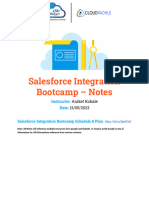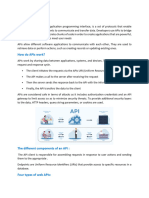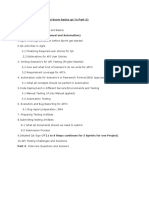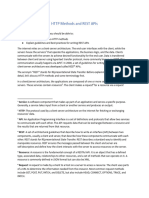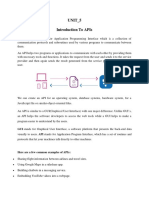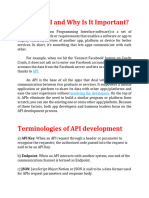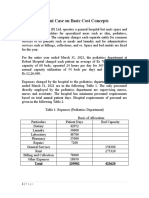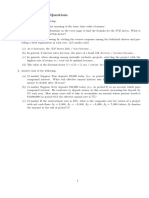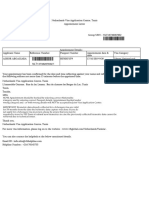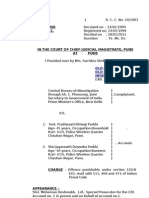Looker and API Concept
Looker
A looker is a powerful business intelligence tool which is used in many fields in almost entire world for
doing analysis, create reports and dash boards through which the load of doing analysis becomes easy.
Features:-
Build AI powered Applications
Transform the data to deliver business insights
Build the custom data
Data Integration
Benefits:-
Reduce the cross-cloud spending
Monetize business data
More collaborative production
Analyse Marketing data
Working Process of Looker:-
Defining The data Model
Generating SQL queries
Executing queries
Returning Results
Visualizing the results
Looker works with transactional database like Oracle and MySQL and also with
analytical database like Big Query, Snowflake, and RedShift.
Using Looker costs different pricing like edition pricing, user pricing and etc.
API
APIs(Application Programming Interface):-APIs are mechanisms that helps two or
more components to communicate each other. API stands for Application Programming Interface ,here
interface can be understood between as a contract between two applications. The weather app is an
example of API.
Working of API is generally between the server and the client. The weather app is client and the
weather's bureau are the server. The weather app sends request to the weather's bureau and the
bureau response to the weather app according to the response.
There are 4 different types of APIs depending upon its architecture :-
SOAP API
RPC API
WebSocket API
REST API
1. SOAP API:-These APIs use Simple Object Access Protocol. Client and server exchange using
XML. This is a less flexible API that was more popular in the past.
2. RPC APIs:-These APIs are called Remote Procedure Calls. The client completes a function (or
procedure) the server, and the server sends the output back to the client.
3. WebSocket APIs:-WebSocket API is another modern API development that uses JSON
objects to pass data. A WebSocket API support two-way communication between client apps and the
server. The server can send callback messages to connected clients, making it more efficient than REST
API.
4. REST API:-The REST API is in high use nowadays; it stands for representational state transfer.
The main feature of REST API is its statelessness . Here statelessness means that the server does not
save the client data between the process.
API Integrations are software components that automatically update data between clients and server.
The example of API integration is syncing the time and zone on our device when moving to other
places.
Benefits of API :-
Integration
Innovation
Expansion
Ease of maintenance
Types of API on the basis of scope of its use :-
1. Private API:-These are internal to an enterprise and only used for connecting systems and
data within the business.
2. Public API:-These are open to public and may be used by anyone. There may or not be some
authorization and cost associated with these types of APIs.
3. Partner API:-These are only accessible by authorized external developers to aid business-to-
business partnerships.
4. Composite API:-These combine two or more different APIs to address complex system
requirements or behaviours.
API endpoints are the final touchpoints in the API communication system. These
includes servers, URLs, locations from where information is sent and received.
API endpoints are critical to enterprises for 2 main reasons :-
Security
Performance
1. Security:-API endpoints make the system vulnerable to attack. API monitoring is crucial for
preventing misuse.
2. Performance:-API endpoints, especially high traffic ones, can cause bottlenecks and affect
system performance.
Due diligence and effort are required to build an API that other developers want to work with and
trust. Here 5 steps taken to build an API:-
1. Plan the API
API specifications, like Open API, provide the blueprint for your API design. It is better to think about
different use cases in advance and ensure the API adheres to current API development standards.
2. Build the API
API designers prototype APIs using boilerplate code. Once the prototype is tested, developers can
customize it to internal specifications.
3. Test the API
API testing is the same as software testing and must be due to prevent bugs and defects. API testing
tools can be used to strength test the API against cyber-attack.
4. Document the API
While APIs are self-explanatory, API documentation acts as a guide to improve usability. Well
documented APIs that offer a range of functions and use cases tend to be more popular in a service-
oriented architecture.
5. Market the API
Just as Amazon is an online marketplace for retail, API marketplaces exist for developers to buy and sell
other APIs. Listing your API can allow you to monetize it.
Request URL
A request URL is a complete web address that a client sends to the server when making request for
information. A request URL consists the path address, the domain name, the hostname. The request is
made through protocol, http & https.
HTTP
It stands for hypertext transfer protocol. A client makes a request and through which it sends the
request is http method this request is received by the server and the server responses to the request in
return this response is again carried by the https method to the client. All this process is possible with
internet connection.
There are some http methods which are as follows:-
get:- retrieves data from server by specifying suitable URL
put:-completely replaces an existing resource with the new data
delete:-deletes a resource on the server
post:-sends data to the server to create new resource
head:-retrieves the header's information without the actual content display
patch:-partially updates a resource
options:-used to discover the capabilities of the server
Status Code
HTTP status code is the three digit code from server side to the browser request. There are many http
status code and some of them are :-
404:- page not found error
200:- the request is successful
Categorization Of Status Code
The http status code is categorised in 5 different ways:-
1. 1xx:-Informational The server has received the request and is continuing the process .
100:-Continue
101:-Switching Protocol
102:-Processing
103:-Early hints, before giving the final message.
2. 2xx:-Successful The request is successful and the browser has received the requested information
200:-Ok
201:-Created
202:-Accepted
203:-Non-Authoritative Information
204:No Content
205:-Reset Content
206:-Partial Content
207:-Multi-Status
208:-Already Reported
209:-IM Used
3. 3xx:-Redirection You have been redirected to some other location and the completion of request
requires further actions.
300:-Multiple Choices
301:-Moved Permanently
302:-Found(Previously "Moved Temporarily")
303:-See other
304:-Not Modified
305:-Use proxy
306:-Switch proxy
307:-Temporary Redirect
308:-Permanent Redirect
4. 4xx:-Client Error The website or page could not be reached, either the page is unavailable or the
syntax is bad.
400:-Bad Request
401:-Unauthorized
402:-Payment Required
403:-Forbidden
404:-Not Found
405:-Method Not Allowed
406:-Not Acceptable
407:-Proxy Authentication required
408:-Time Out
409:-Conflict
410:-Gone
411:-Length Required
412:-Precondition Failed
413:-Payload Too Large
414:-URL Too Long
415:-Unsupportable Media Type
416:-Range Not Satisfiable
417:-Expectation Failed
418:-I'm a teapot
421:-Misdirected Request
422:-Un processable Content
423:-Locked
424:-Failed Dependency
425:-Too Early
426:-Upgrade Required
428:-Precondition Required
429:-Too Many Requests
431:-Request Header Fields Too Large
451:-Unavailable For Legal Reasons
5. 5xx:-Server error While the request appears to be valid but the server could not complete the
request.
500:-Internal Server Error
501:-Not Implemented
502:-Bad Gateway
503:-Service Unavailable
504:-Gateway Timeout
505:-HTTP Version Not Supported
506:-Variant Also Negotiates
507:-Insufficient Storage
508:-Loop Detected
510:-Not Extended
511:-Network Authentication




